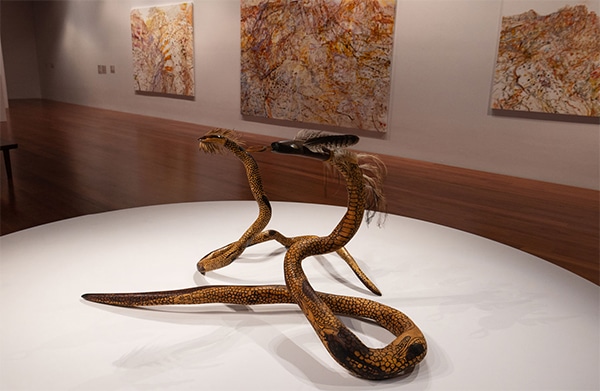Kyron Weetra, Earthy artworks a poignant reflection of the ancient lands that inspired them,
Spearheaded by Adnyamathanha artists, the Mulka Yata/The Knowledge of Place exhibition illuminates the ancient landscapes of the Ikara-Flinders Ranges and the culture that continues to thrive there.

Mulka Yata/The Knowledge of Place is an immersively reverent homage to the championing of the Adnyamathanha culture and landscape featuring work spanning four generations of traditional wood carvers in Kristian Coulthard, Clem Coulthard, Ted Coulthard and Winnie Ryan. In the Adnyamathanha language, “Adnya” means rock and “Mathanha” means people, making the custodians of the Ikara-Flinders Ranges “the people of the rocks”.
The Flinders is the only place on Earth where 350 million years of near-continuous geological sequencing can be seen, while also containing the richest trove of Ediacara fossils – a record of the first multicellular organisms, formed more than 600 million years ago. It seems fitting, then, that Adnyamathanha culture has been so greatly preserved and championed, like the land itself, and in no greater way could Mulka Yata showcase this.
Kristian Coulthard, through his artwork, honours the way of his ancestors in a palpably real way. This process is described in a documentary about Kristian’s cultural connections and his artistic techniques which was filmed at his art studio/gallery called Wadna in the town of Blinman. Produced by Jared Thomas (a Nukunu person and co-curator of this exhibition with Erica Green) and Malcolm McKinnon, the documentary showcases the constant connection to the way the ancestors worked their craft and how that is still lived today by using shared techniques, tools and language.
Kristian’s centrepiece sculptures of various Akurra, or serpent deities, are mesmerisingly scaled in carved acacia and adorned with emu feathers. The work excels as a hypnotically effective tribute to a keystone of Adnyamathanha culture.

Ted Coulthard is Kristian’s grandfather and his work may be seen as the earliest surviving example of Aboriginal carvings from the Adnyamathanha art movement, at least to be traded with pastoralists. The oldest piece on show is Ted’s Yakadi (walking stick) from the mid-1890s. A fluid entanglement of two serpents rise up the shaft of the Yakadi; atop sits a Wildu (eagle), which is grasping the head of one of the snakes in its claws. This itself marks the beginning of the modern Adnyamathanha art movement and the industrious commodification of Aboriginal art as a means of income and survival in an ever-taking colonial landscape.
Winnie Ryan, Ted’s wife and mother of Clem, would create constantly in collaboration with Ted and they worked hard to maintain a high quality of craftsmanship. In all there are more than 20 Coulthard wood carvings in the exhibition, spanning more than 130 years of history.
Shockingly, Mulka Yata is Kristian Coulthard’s first public gallery exhibition and the first time his works has stood alongside that of his non-Indigenous contemporaries. Perhaps the most visually striking of the latter is Kyoko Hashimoto and Guy Keulemans’ Bioregional rings, an earthy set of paper mache sculptures of Adnyamathanha rocks made from native wood, paper and ochres. Using these “transitional” mediums aims not to disturb the land that inspired the work, in keeping with the Shinto tradition of rocks having a “spiritual essence” and of not moving rocks that have particularly “potent” spiritual energy.

With the number of artists and mediums represented, it is commendable that all of these artworks reflect alternate angles of perception onto other works within the exhibition, which builds an accumulative fascination and understanding. Antony Hamilton’s Hung White Fox and Shadow is a noir-esque installation of an albino fox being strung up by the leg in a harsh spotlight hovering over fencing wire, giving the viewer an unsettling and jarring feeling of imbalance and judgment.
Conversely, sound installations created Sasha Grbich – who draws from her experience on Nukunu Country, particularly Saltia Creek Gorge and the various mangroves of the southern coast – aim to decolonise the visual space of this country and the gallery that houses it, and tip the balance back into nature’s favour.

The ambience created by such earthy artworks in a rich tapestry of mediums creates a poignantly spiritual reflection of the ancient lands that inspired and incubated them. The powerful sharing and resonating of various perspectives from a place of earnest respect and creativity is quite overwhelming in its magnitude and scope. I remain in awe of the reverence showcased to Country and culture.
This exhibition and its wonders are far too wide and rich to fully reflect here, so I recommend you indulge yourself in the experience of Mulka Yata.
Mulka Yata/The Knowledge of Place is a Samstag Museum of Art exhibition with the South Australian Museum, curated by Erica Green (Samstag) and Jared Thomas (SA Museum). It in the Samstag Galleries 1 and 3 until September 20.

